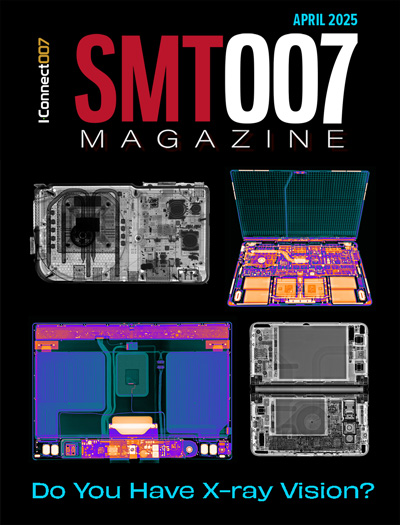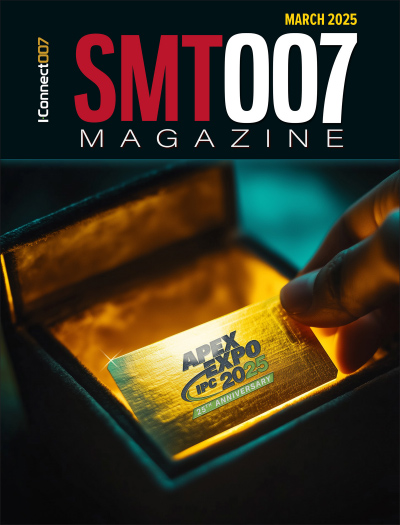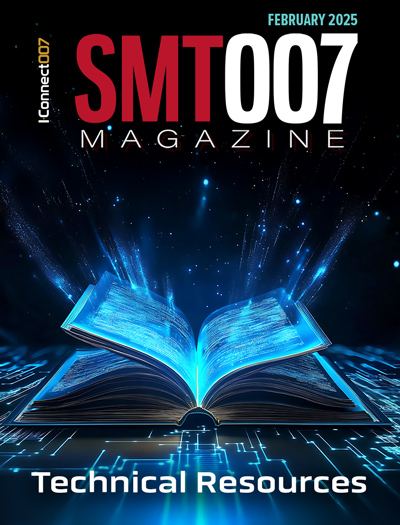-

- News
- Books
Featured Books
- smt007 Magazine
Latest Issues
Current Issue
Do You Have X-ray Vision?
Has X-ray’s time finally come in electronics manufacturing? Join us in this issue of SMT007 Magazine, where we answer this question and others to bring more efficiency to your bottom line.

IPC APEX EXPO 2025: A Preview
It’s that time again. If you’re going to Anaheim for IPC APEX EXPO 2025, we’ll see you there. In the meantime, consider this issue of SMT007 Magazine to be your golden ticket to planning the show.

Technical Resources
Key industry organizations–all with knowledge sharing as a part of their mission–share their technical repositories in this issue of SMT007 Magazine. Where can you find information critical to your work? Odds are, right here.
- Articles
- Columns
Search Console
- Links
- Media kit
||| MENU - smt007 Magazine
Flex Factory in Sorocaba, Brazil Admitted into World Economic Forum Global Lighthouse Network
October 12, 2022 | FlexEstimated reading time: 2 minutes
Flex announced its factory site in Sorocaba, Brazil has been admitted into the World Economic Forum’s Global Lighthouse Network (GLN). This recognition is a result of the Fourth Industrial Revolution (4IR) technology adoption journey this Flex factory embarked on in 2017 that put equal emphasis on sustainability, people and economic growth. The GLN is a community of manufacturers that are world leaders in the adoption and integration of cutting-edge 4IR technologies to maximize efficiency and competitiveness at scale, transform business models and protect the environment. Flex CEO Revathi Advaithi will participate as a guest expert/speaker on a virtual panel hosted by the World Economic Forum Global Lighthouse Network on October 13 at 14:00 CEST titled, “Unlocking Sustainable and Human Centric Operations Using 4IR Technologies.”
The site in Sorocaba is the second Flex factory to be admitted into the GLN. Through the rigorous admission process, the company demonstrated how it has deployed 4IR initiatives along the end-to-end value chain to increase agility and operational efficiencies. The site has deeply embedded sustainability into its operations with a circular economy ecosystem. People remain a focus, improving engagement by upskilling employees and increasing team member well-being through innovative digital health and safety measures. It has also increased customer satisfaction by providing improved transparency and quality.
“The Flex factory site in Sorocaba, Brazil is leading the way for the future of manufacturing by leveraging 4IR technologies to achieve not only efficiency and quality, but also prioritizing sustainability and employee care, which are critical elements for Global Lighthouse factories,” said Francisco Betti, Head of Shaping the Advanced Manufacturing and Production Platform, World Economic Forum. “Being part of the Lighthouse network, manufacturers can collaborate and share insights with like-minded peers, to unlock new levels of sustainability in their operations and to lead towards a cleaner future.”
“Flex is focused on delivering manufacturing excellence for its customers and the site in Sorocaba is a shining example. We are honored to be recognized as one of the first Global Lighthouse Network factories in Brazil,” said Hooi Tan, President, Global Operations and Supply Chain, Flex. “We look forward to our continued participation in the World Economic Forum’s Global Lighthouse Network, sharing our experiences and best practices in developing sustainable, advanced manufacturing capabilities at scale and collaborating with others in the industry to proliferate the adoption of Industry 4.0 technologies for advanced manufacturing.”
The nomination of the Sorocaba site showcased the following innovation areas:
- Implemented a real time, IIoT-enabled digital factory performance management system connected to 44 production lines. This provides real-time data and transparency, resulting in material loss reduction by 81% and an overall equipment effectiveness (OEE) increase of 23%.
- Developed a circular economy ecosystem, including reverse logistics of electronic waste leveraging IoT and cloud for real time tracking, resulting in a 94% reduction of material waste and a 38% reduction of plastic material costs. This reduced the need for resources equivalent to 44K carbon credits accredited by the Canadian Standard Association (CSA).
- Created an end-to-end ergonomics digital thread with real time monitoring of operators who are alerted when a job rotation or workstation ergonomics improvement needs to be made to ensure employee health and safety.
- Upskilled over 200 employees on developing and using low and no code digital tools and implemented Robotic Process Automation (RPA) solutions. This eliminated repetitive tasks for humans, resulting in a 38% reduction in nonvalue added work, and an increase of both employee and customer satisfaction.
- Implemented an advanced real time supply chain solution to accelerate product flow, creating on-demand transparency and enabling supply chain resiliency.
Suggested Items
CEE PCB Appoints Markus Voeltz to Business Development Director Europe
04/02/2025 | CEE PCBCEE PCB, a leading manufacturer of printed circuit boards (PCBs) and flexible printed circuits (FPCs) with 3 production facilities in China, is expanding its presence in Europe and began providing local support in March 2025. With 25 years of experience in the industry, the company is enhancing its commitment to European customers by providing more direct collaboration for technical inquiries and advice.
Real Time with... IPC APEX EXPO 2025: Discover Comprehensive PCB Solutions with American Standard Circuits
04/01/2025 | Real Time with...IPC APEX EXPOAnaya Vardya, CEO of American Standard Circuits, highlights the company's dedication to offering complete PCB solutions. The company provides free design packages and caters to various sectors, including military and telecommunications.
Metanoia Licenses Cadence Tensilica ConnX 230 DSP for New SDR Platform
03/26/2025 | Cadence Design SystemsThe transition from analog to software-defined radio (SDR) represents a significant advancement in communication technology. Traditional analog systems rely heavily on fixed hardware for signal processing, which limits their flexibility and adaptability.
Global PCB Connections: A Field Engineer’s Perspective on the Top 10 Trends to Watch
03/27/2025 | Jerome Larez -- Column: Global PCB ConnectionsAs a field application engineer for a major Chinese PCB company, I see firsthand the challenges and, more excitingly, the trends shaping our industry. Talking to engineers, designers, and procurement teams worldwide, one thing is clear: PCBs have come a long way, but we’re barely scratching the surface of what’s possible. Here are 10 trends I believe will define our industry over the next decade.
Flexible Thinking: The Key to a Successful Flex Circuit Design Transfer
03/26/2025 | Joe Fjelstad -- Column: Flexible ThinkingThis month, I will discuss the most common design errors that fabricators see, typical areas of miscommunication between design and fabrication, and what designers can do to avoid putting their jobs on hold. This is no simple task, given the many things that can go wrong in flex circuit manufacturing, but many of these issues originate in the design process.


